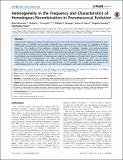Heterogeneity in the Frequency and Characteristics of Homologous Recombination in Pneumococcal Evolution

View/
Author
Mostowy, Rafal
Croucher, Nicholas J.
Harris, Simon R.
Bentley, Stephen
Fraser, Christophe
Published Version
https://doi.org/10.1371/journal.pgen.1004300Metadata
Show full item recordCitation
Mostowy, Rafal, Nicholas J. Croucher, William P. Hanage, Simon R. Harris, Stephen Bentley, and Christophe Fraser. 2014. “Heterogeneity in the Frequency and Characteristics of Homologous Recombination in Pneumococcal Evolution.” PLoS Genetics 10 (5): e1004300. doi:10.1371/journal.pgen.1004300. http://dx.doi.org/10.1371/journal.pgen.1004300.Abstract
The bacterium Streptococcus pneumoniae (pneumococcus) is one of the most important human bacterial pathogens, and a leading cause of morbidity and mortality worldwide. The pneumococcus is also known for undergoing extensive homologous recombination via transformation with exogenous DNA. It has been shown that recombination has a major impact on the evolution of the pathogen, including acquisition of antibiotic resistance and serotype-switching. Nevertheless, the mechanism and the rates of recombination in an epidemiological context remain poorly understood. Here, we proposed several mathematical models to describe the rate and size of recombination in the evolutionary history of two very distinct pneumococcal lineages, PMEN1 and CC180. We found that, in both lineages, the process of homologous recombination was best described by a heterogeneous model of recombination with single, short, frequent replacements, which we call micro-recombinations, and rarer, multi-fragment, saltational replacements, which we call macro-recombinations. Macro-recombination was associated with major phenotypic changes, including serotype-switching events, and thus was a major driver of the diversification of the pathogen. We critically evaluate biological and epidemiological processes that could give rise to the micro-recombination and macro-recombination processes.Other Sources
http://www.ncbi.nlm.nih.gov/pmc/articles/PMC4006708/pdf/Terms of Use
This article is made available under the terms and conditions applicable to Other Posted Material, as set forth at http://nrs.harvard.edu/urn-3:HUL.InstRepos:dash.current.terms-of-use#LAACitable link to this page
http://nrs.harvard.edu/urn-3:HUL.InstRepos:12406891
Collections
- SPH Scholarly Articles [6362]
Contact administrator regarding this item (to report mistakes or request changes)


